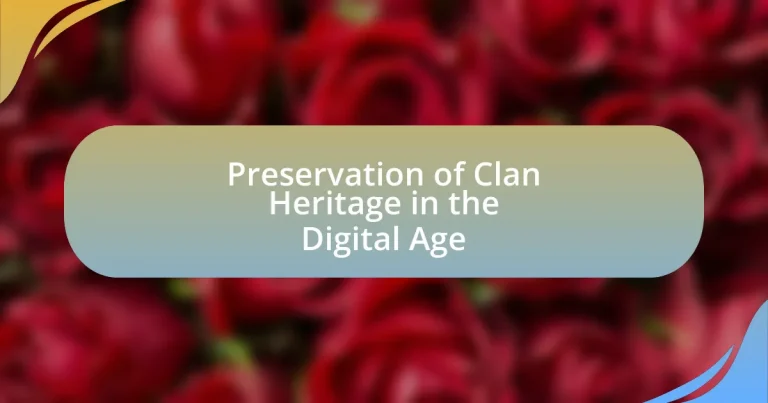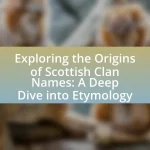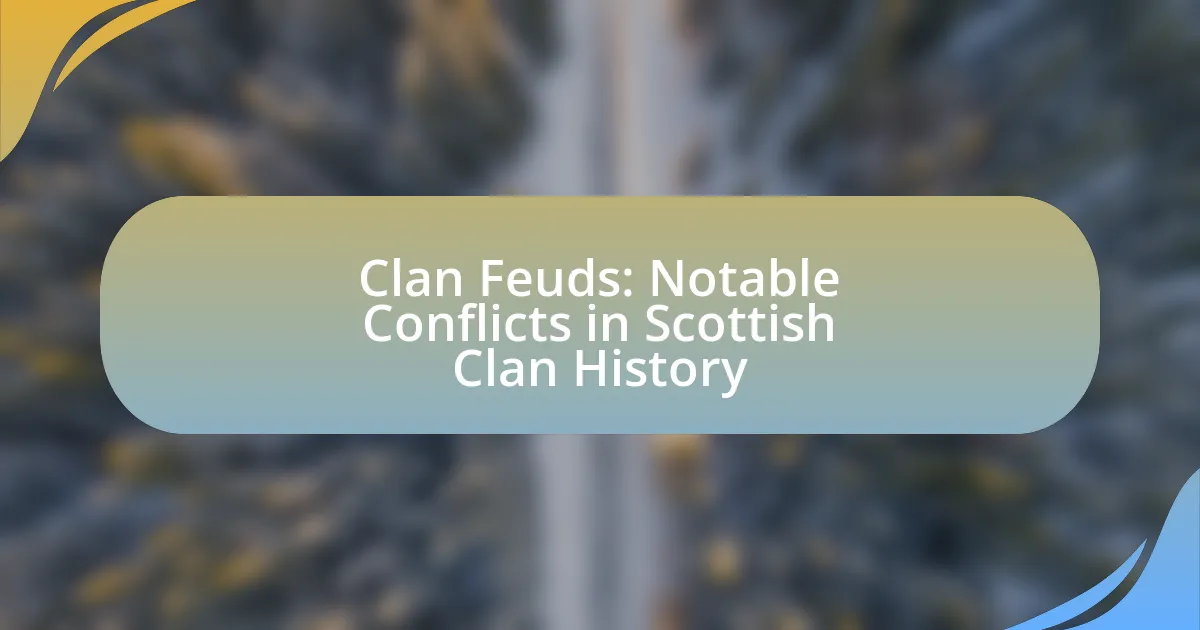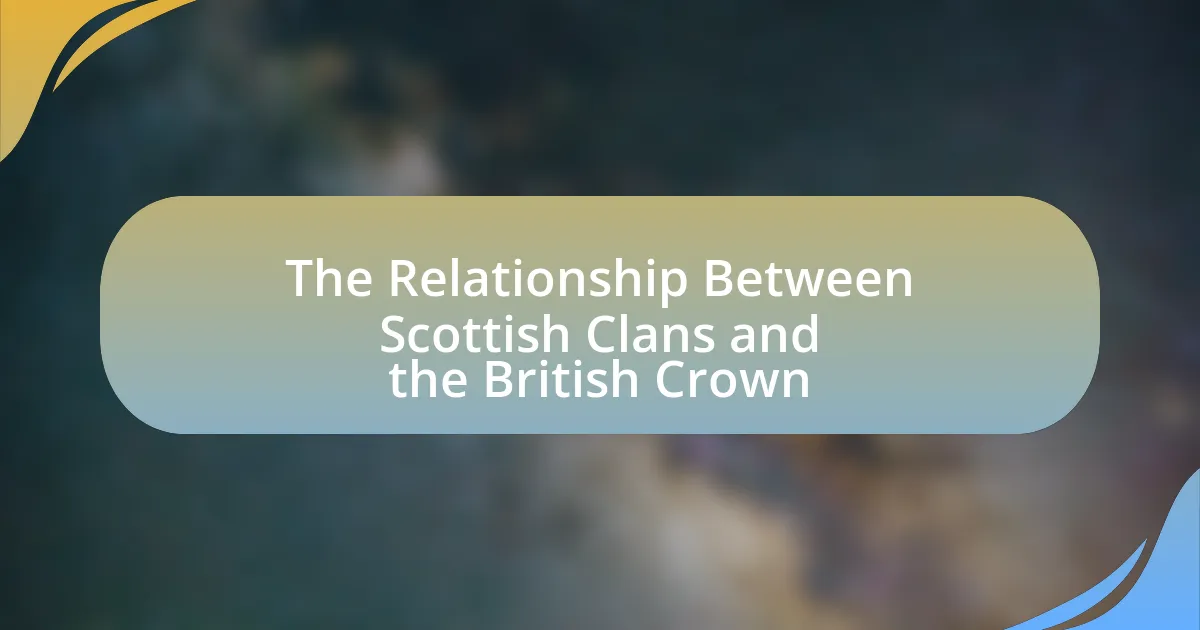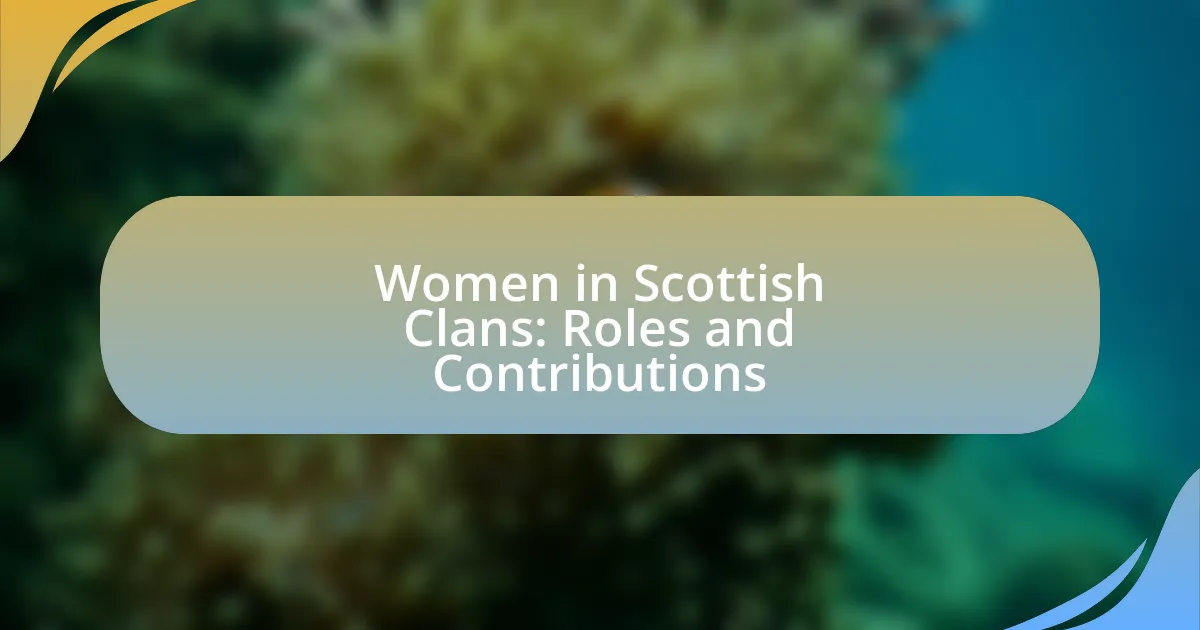The preservation of clan heritage in the digital age focuses on utilizing technology to document, share, and maintain the cultural practices, histories, and identities of clans. Key methods include digital archiving, social media engagement, and interactive websites, which enhance accessibility and community involvement. The article discusses the importance of preserving clan heritage amidst globalization, the risks posed by misinformation and the digital divide, and the role of innovative technologies like virtual reality and artificial intelligence in safeguarding cultural narratives. Additionally, it outlines practical steps clans can take to ensure effective digital preservation and highlights available resources for initiating these efforts.

What is the Preservation of Clan Heritage in the Digital Age?
The preservation of clan heritage in the digital age involves the use of technology to document, share, and maintain the cultural practices, histories, and identities of clans. Digital tools such as social media, websites, and databases enable clans to archive oral histories, traditional practices, and genealogical records, ensuring that these elements are accessible to future generations. For instance, platforms like Ancestry.com and FamilySearch allow users to trace lineage and connect with relatives, thereby fostering a sense of community and continuity. Additionally, digital storytelling initiatives and online cultural exhibitions help to showcase clan traditions and narratives, making them available to a global audience. This approach not only safeguards clan heritage but also promotes cultural exchange and understanding in an increasingly interconnected world.
Why is preserving clan heritage important in today’s digital world?
Preserving clan heritage is crucial in today’s digital world because it fosters cultural identity and continuity amidst rapid globalization. In a time when digital platforms can dilute traditional values, maintaining clan heritage ensures that unique customs, languages, and histories are transmitted to future generations. For instance, studies show that communities with strong cultural ties exhibit greater social cohesion and resilience, which is vital in an increasingly interconnected society. Furthermore, digital tools can enhance the preservation process by documenting oral histories and traditional practices, making them accessible to a broader audience and reinforcing the importance of cultural diversity in the global narrative.
What aspects of clan heritage are most at risk in the digital age?
Aspects of clan heritage most at risk in the digital age include traditional knowledge, oral histories, and cultural practices. The rapid digitization of information often leads to the loss of nuanced cultural expressions that are not easily captured in digital formats. For instance, oral traditions, which are vital for passing down clan stories and values, may diminish as younger generations increasingly rely on digital media for information. Additionally, the commercialization of cultural symbols can lead to misrepresentation and appropriation, further threatening the authenticity of clan heritage. Studies indicate that over 70% of indigenous languages, which are crucial for cultural identity, are at risk of extinction due to digital influences and globalization.
How does digital technology impact the preservation of clan heritage?
Digital technology significantly enhances the preservation of clan heritage by enabling the documentation, storage, and sharing of cultural practices and histories. For instance, digital archiving allows clans to create comprehensive databases of oral histories, traditional practices, and genealogies, which can be accessed by future generations. Additionally, social media platforms facilitate the dissemination of cultural narratives and foster community engagement, ensuring that clan heritage remains vibrant and relevant. Research indicates that digital tools, such as virtual reality and augmented reality, can recreate historical sites and events, providing immersive experiences that deepen understanding and appreciation of clan heritage.
What are the key methods for preserving clan heritage digitally?
Key methods for preserving clan heritage digitally include creating digital archives, utilizing social media platforms, and developing interactive websites. Digital archives allow for the systematic collection and storage of documents, photographs, and oral histories, ensuring that clan narratives are accessible and preserved for future generations. Social media platforms facilitate community engagement and sharing of heritage stories, fostering connections among clan members and promoting cultural awareness. Interactive websites can serve as educational resources, showcasing clan history, traditions, and genealogies, which enhances the understanding and appreciation of clan heritage. These methods collectively contribute to the safeguarding of cultural identity in the digital era.
How can social media be utilized for clan heritage preservation?
Social media can be utilized for clan heritage preservation by creating dedicated platforms for sharing stories, traditions, and historical documents related to the clan. These platforms enable members to connect, collaborate, and contribute content that reflects their heritage, fostering a sense of community and continuity. For instance, clans can establish Facebook groups or Instagram pages to post photographs, videos, and narratives that highlight their cultural practices and lineage. Research indicates that social media facilitates intergenerational communication, allowing older members to share knowledge with younger generations, thus ensuring the transmission of cultural values and practices.
What role do digital archives play in preserving clan history?
Digital archives play a crucial role in preserving clan history by providing a centralized, accessible platform for storing and sharing historical documents, photographs, and oral histories. These digital repositories enable clans to maintain their cultural narratives and genealogical records, ensuring that vital information is not lost over time. For instance, organizations like the National Archives and Records Administration have digitized millions of documents, allowing families to trace their lineage and understand their heritage more effectively. This accessibility fosters a sense of identity and continuity among clan members, reinforcing community bonds and cultural pride.
What challenges are faced in the digital preservation of clan heritage?
Digital preservation of clan heritage faces several challenges, including technological obsolescence, data degradation, and cultural sensitivity. Technological obsolescence occurs as software and hardware evolve, making it difficult to access older digital formats; for instance, many early digital files are now unreadable due to outdated systems. Data degradation refers to the deterioration of digital files over time, which can lead to loss of information if not properly managed. Cultural sensitivity is crucial, as clan heritage often involves sacred or private information that may not be suitable for public access, raising ethical concerns about what should be preserved and shared. These challenges necessitate careful planning and resources to ensure the integrity and accessibility of clan heritage in the digital realm.
How does digital divide affect clan heritage preservation efforts?
The digital divide significantly hampers clan heritage preservation efforts by limiting access to digital tools and resources necessary for documentation and dissemination. Many clans, particularly those in rural or economically disadvantaged areas, lack reliable internet access and digital literacy, which restricts their ability to engage in online platforms for sharing their heritage. For instance, a report by the International Telecommunication Union indicates that nearly 3.7 billion people remain offline, disproportionately affecting marginalized communities. This lack of access prevents clans from utilizing digital archives, social media, and other online resources that could help preserve and promote their cultural practices and histories. Consequently, the digital divide creates a barrier to effective heritage preservation, leading to potential loss of cultural identity and historical knowledge.
What are the risks of misinformation in digital clan heritage narratives?
Misinformation in digital clan heritage narratives poses significant risks, including the distortion of cultural identity and the erosion of historical accuracy. When inaccurate information is disseminated, it can lead to misunderstandings about clan origins, traditions, and values, ultimately undermining the integrity of the heritage being preserved. For instance, a study by the Pew Research Center highlights that 64% of Americans believe that misinformation has caused confusion about important issues, which can extend to cultural narratives as well. This confusion can result in a fragmented understanding of clan history, leading to divisions within communities and a loss of shared identity. Furthermore, misinformation can perpetuate stereotypes and biases, negatively impacting the perception of clans in broader societal contexts.
How can communities engage in the digital preservation of their clan heritage?
Communities can engage in the digital preservation of their clan heritage by creating and maintaining digital archives that document their history, traditions, and cultural practices. This can involve collecting oral histories, photographs, documents, and artifacts, and digitizing them for online access. For instance, the Library of Congress has successfully digitized historical documents, making them accessible to a wider audience, which demonstrates the effectiveness of digital archiving. Additionally, communities can utilize social media platforms to share stories and engage younger generations, ensuring that clan heritage remains relevant and preserved for future generations.
What are the best practices for documenting clan heritage online?
The best practices for documenting clan heritage online include creating a centralized digital archive, utilizing multimedia formats, ensuring accurate and thorough record-keeping, and engaging the community. A centralized digital archive allows for organized storage and easy access to clan history, while multimedia formats such as videos, photographs, and audio recordings enhance the storytelling aspect and preserve the emotional context of heritage. Accurate record-keeping is essential to maintain the integrity of the information, which can be supported by cross-referencing with historical documents and genealogical databases. Engaging the community fosters collaboration and encourages contributions from clan members, enriching the collective heritage. These practices are supported by the increasing trend of digital preservation efforts, as seen in initiatives like the Digital Public Library of America, which emphasizes the importance of accessible and well-documented cultural heritage.
How can storytelling be effectively used in digital clan heritage projects?
Storytelling can be effectively used in digital clan heritage projects by creating immersive narratives that connect individuals to their ancestral roots and cultural practices. This approach engages users emotionally, fostering a sense of belonging and identity. For instance, digital platforms can utilize multimedia elements such as videos, audio recordings, and interactive timelines to present clan histories and personal stories, making the content more relatable and impactful. Research indicates that narratives enhance memory retention and understanding, which is crucial for preserving cultural heritage. By integrating storytelling techniques, digital clan heritage projects can ensure that traditions and histories are not only documented but also experienced, thereby promoting intergenerational knowledge transfer.
What tools and platforms are recommended for clan heritage documentation?
Recommended tools and platforms for clan heritage documentation include Ancestry.com, FamilySearch, and MyHeritage. Ancestry.com offers extensive genealogical records and user-friendly family tree building tools, making it suitable for documenting clan lineage. FamilySearch provides free access to a vast collection of historical records and community support for family history research. MyHeritage combines DNA testing with family tree building and offers features for preserving photos and stories, enhancing the documentation of clan heritage. These platforms are widely recognized for their effectiveness in genealogical research and heritage preservation.
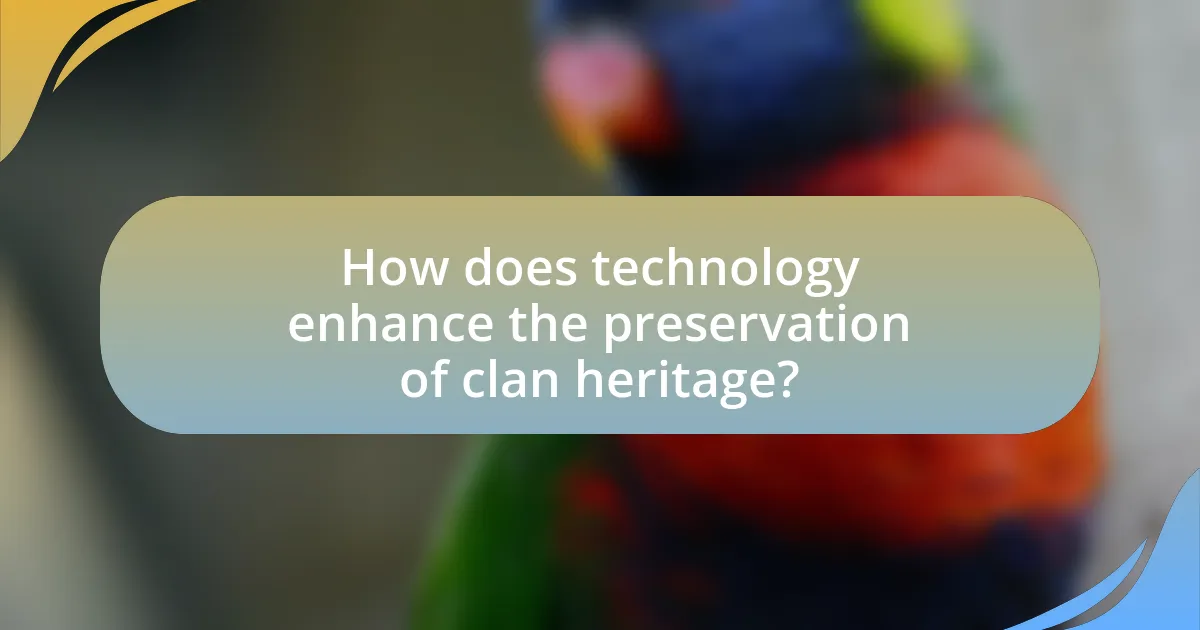
How does technology enhance the preservation of clan heritage?
Technology enhances the preservation of clan heritage by enabling the digitization of cultural artifacts, oral histories, and traditions. This process allows for the creation of digital archives that can be accessed globally, ensuring that clan heritage is not lost to time or geographical barriers. For instance, platforms like the Internet Archive and various cultural heritage projects have successfully digitized thousands of documents and recordings, making them available for future generations. Additionally, social media and online communities facilitate the sharing of clan stories and practices, fostering a sense of belonging and continuity among members. These technological advancements not only safeguard heritage but also promote its active engagement and revitalization within contemporary contexts.
What innovative technologies are being used for clan heritage preservation?
Innovative technologies used for clan heritage preservation include digital archiving, 3D modeling, and augmented reality applications. Digital archiving allows for the systematic collection and storage of historical documents, photographs, and oral histories, making them accessible to future generations. 3D modeling enables the recreation of significant cultural artifacts and sites, providing immersive experiences that enhance understanding and appreciation of heritage. Augmented reality applications overlay digital information onto physical locations, enriching the visitor experience and promoting engagement with clan history. These technologies collectively support the preservation and dissemination of clan heritage in a rapidly evolving digital landscape.
How can virtual reality contribute to the experience of clan heritage?
Virtual reality can significantly enhance the experience of clan heritage by providing immersive environments that allow individuals to engage with their cultural history in a dynamic way. Through virtual reality, users can explore reconstructed historical sites, participate in traditional ceremonies, and interact with digital representations of ancestral artifacts, thereby fostering a deeper emotional connection to their heritage. Studies have shown that immersive experiences can improve retention of cultural knowledge and increase appreciation for one’s heritage, as evidenced by research conducted by the University of Southern California, which found that virtual reality experiences can lead to a 30% increase in cultural engagement among participants.
What role does artificial intelligence play in archiving clan histories?
Artificial intelligence plays a crucial role in archiving clan histories by automating the organization, analysis, and preservation of historical data. AI technologies, such as natural language processing and machine learning, enable the digitization of oral histories, documents, and artifacts, making them more accessible and searchable. For instance, AI can transcribe and analyze audio recordings of clan stories, allowing for the extraction of key themes and connections that might be overlooked by human archivists. This capability enhances the preservation of cultural narratives and ensures that clan histories are maintained for future generations.
How can digital preservation efforts be sustained over time?
Digital preservation efforts can be sustained over time through continuous funding, technological updates, and community engagement. Continuous funding ensures that resources are available for maintaining digital archives, as evidenced by the National Archives and Records Administration, which allocates budget for digital preservation initiatives. Technological updates are crucial, as formats and storage media evolve; for instance, the Library of Congress regularly updates its digital preservation strategies to accommodate new technologies. Community engagement fosters a sense of ownership and responsibility, as seen in projects like the Digital Public Library of America, which involves local communities in the preservation process. These combined strategies create a robust framework for sustaining digital preservation efforts effectively.
What funding opportunities exist for digital clan heritage projects?
Funding opportunities for digital clan heritage projects include grants from cultural heritage organizations, government funding programs, and private foundations. For instance, the National Endowment for the Humanities offers grants specifically for digital projects that preserve cultural heritage, while the Heritage Lottery Fund in the UK provides funding for projects that engage communities with their heritage. Additionally, organizations like the American Council of Learned Societies support digital initiatives that enhance the understanding of cultural history. These funding sources are designed to support projects that document, preserve, and promote clan heritage through digital means, ensuring that cultural narratives are accessible to future generations.
How can collaboration among clans enhance preservation efforts?
Collaboration among clans can enhance preservation efforts by pooling resources, knowledge, and cultural practices to create a more comprehensive approach to heritage conservation. When clans work together, they can share best practices, access funding opportunities, and develop joint initiatives that amplify their impact. For instance, a study by the International Council on Monuments and Sites (ICOMOS) highlights that collaborative projects often lead to increased community engagement and awareness, which are crucial for sustaining preservation efforts. By uniting their strengths, clans can effectively safeguard their cultural heritage against threats such as globalization and environmental changes.
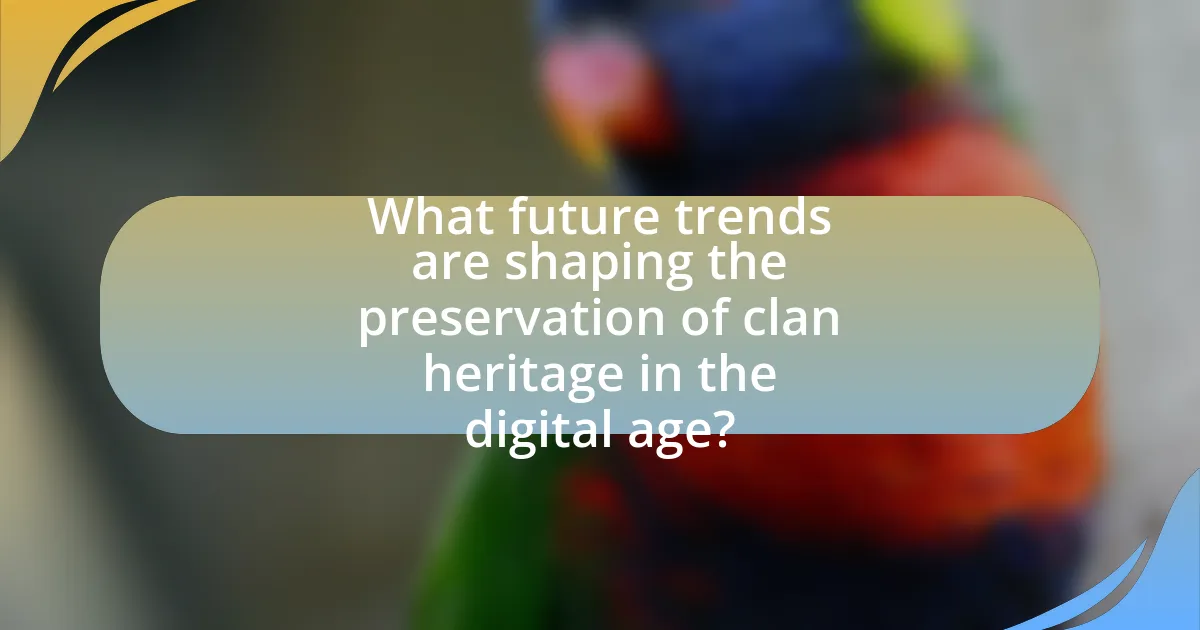
What future trends are shaping the preservation of clan heritage in the digital age?
Future trends shaping the preservation of clan heritage in the digital age include the use of digital archiving, social media engagement, and virtual reality experiences. Digital archiving allows clans to store and share historical documents, photographs, and oral histories online, making them accessible to a wider audience. Social media platforms facilitate community building and the sharing of cultural practices, enabling clans to connect with younger generations and promote their heritage. Virtual reality experiences offer immersive ways to engage with clan history, allowing users to explore significant sites and events in a dynamic format. These trends are supported by increasing internet accessibility and advancements in technology, which enhance the ability to preserve and promote clan heritage effectively.
How is the rise of blockchain technology influencing heritage preservation?
The rise of blockchain technology is significantly influencing heritage preservation by providing secure, immutable records of cultural artifacts and historical data. Blockchain enables the documentation of provenance, ensuring that the history and ownership of heritage items are transparently recorded and easily verifiable. For instance, projects like Artory and Myco use blockchain to create digital certificates for artworks and artifacts, which helps prevent forgery and loss of cultural heritage. Additionally, blockchain facilitates decentralized storage of heritage information, allowing communities to maintain control over their cultural narratives while ensuring accessibility and preservation against loss or destruction.
What potential does crowdsourcing have for clan heritage projects?
Crowdsourcing has significant potential for clan heritage projects by enabling the collection and sharing of diverse historical data and personal narratives from clan members worldwide. This collaborative approach allows clans to gather a wealth of information, such as genealogical records, oral histories, and cultural artifacts, which might otherwise remain undocumented. For instance, platforms like FamilySearch and Ancestry.com utilize crowdsourcing to enhance their databases, allowing users to contribute and verify family histories, thereby enriching the collective knowledge of clan heritage. Additionally, crowdsourcing can foster community engagement and strengthen clan identity by encouraging participation from members across different regions, leading to a more comprehensive and inclusive representation of the clan’s history.
How might future generations engage with clan heritage digitally?
Future generations might engage with clan heritage digitally through immersive technologies such as virtual reality (VR) and augmented reality (AR), which allow users to experience historical events and cultural practices in an interactive manner. These technologies can recreate ancestral environments and rituals, making heritage more accessible and engaging. For instance, platforms like Oculus and AR applications can provide simulations of clan gatherings or traditional ceremonies, enhancing understanding and appreciation of cultural roots. Additionally, social media and online communities can facilitate the sharing of stories, artifacts, and genealogical research, fostering connections among clan members worldwide. Research indicates that digital storytelling and online heritage projects significantly increase youth engagement with cultural history, as seen in initiatives like the “Digital Public Library of America,” which showcases diverse cultural narratives.
What practical steps can clans take to ensure their heritage is preserved digitally?
Clans can ensure their heritage is preserved digitally by creating comprehensive digital archives that include photographs, documents, oral histories, and genealogical records. Establishing a centralized online platform, such as a website or a cloud-based repository, allows for easy access and sharing of these materials among clan members. Additionally, clans should engage in digitizing physical artifacts and records, utilizing high-quality scanning and photography techniques to maintain detail and clarity. Collaborating with local historical societies or universities can provide expertise and resources for preservation efforts. Furthermore, implementing regular updates and maintenance of digital content ensures that the heritage remains relevant and accessible over time.
How can clans create a digital strategy for heritage preservation?
Clans can create a digital strategy for heritage preservation by developing a comprehensive plan that incorporates digital archiving, community engagement, and online education. Digital archiving involves collecting and storing historical documents, photographs, and oral histories in accessible online databases, which can be achieved through platforms like Omeka or Archive.org. Community engagement can be fostered through social media campaigns and interactive websites that encourage clan members to share their stories and artifacts, thereby enhancing collective memory. Online education initiatives, such as webinars and virtual workshops, can disseminate knowledge about clan history and cultural practices, ensuring that younger generations remain connected to their heritage. These strategies are supported by successful case studies, such as the Scottish Clan Heritage Trust, which utilizes digital tools to promote clan history and foster community involvement.
What resources are available for clans looking to start digital preservation initiatives?
Clans looking to start digital preservation initiatives can access various resources, including funding opportunities, training programs, and digital tools. Organizations such as the National Archives and Records Administration (NARA) provide grants specifically for digital preservation projects, while institutions like the Library of Congress offer training workshops on digital preservation techniques. Additionally, software solutions such as Preservica and ArchivesSpace facilitate the management and preservation of digital assets. These resources are essential for clans to effectively safeguard their heritage in the digital age.
